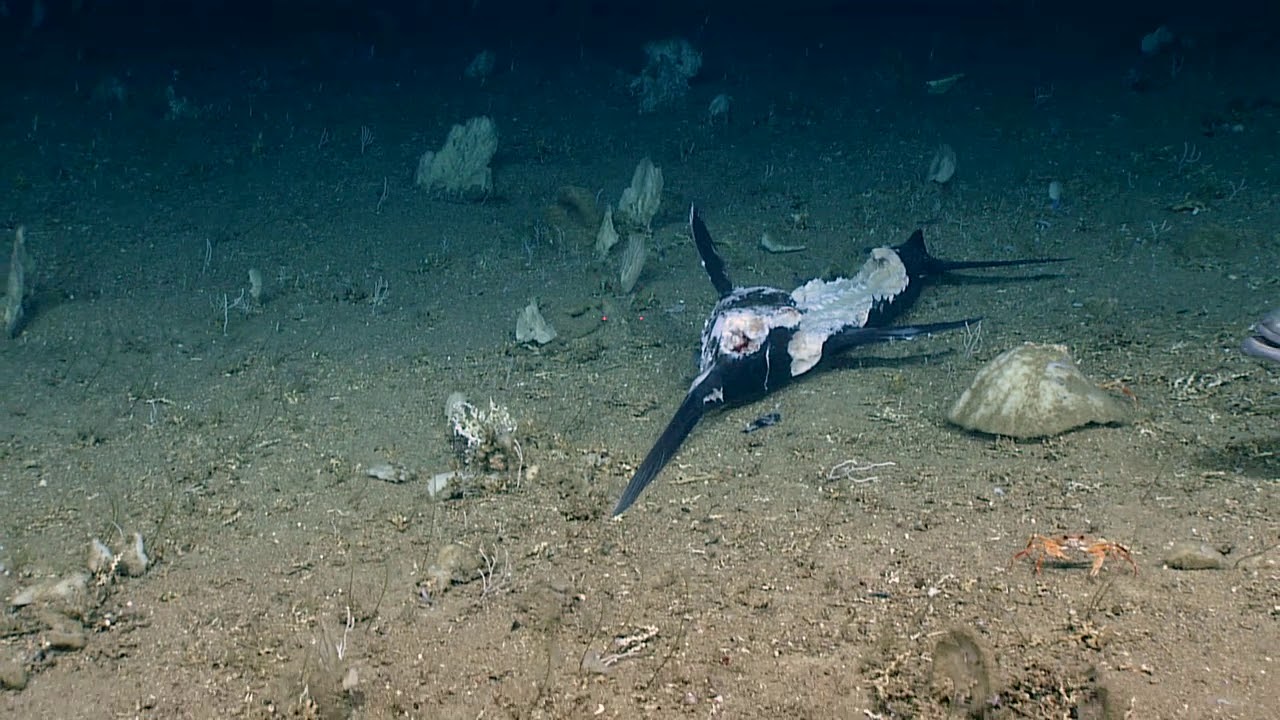A video posted by the US National Oceanic and Atmospheric Administration (NOAA) shows the aftermath of the ambush by a hungry wreckfish. You can watch it for yourself in the clip above, with shark lunch being served at around 1:42.
Dive 07: Oh My Grouper, Look at that Shark
by Peter J. Auster, Mystic Aquarium and University of Connecticut
June 28, 2019
Sometimes “sharks just happen.” You can’t plan on seeing these kinds of things, especially in the deep ocean. It is simply serendipity; by just spending enough time underwater and being prepared for the unexpected, you can stumble across scenes that will replay in your mind’s eye over and over for a lifetime. Thanks to remotely operated vehicle Deep Discoverer (D2) and the telepresence capabilities of NOAA Ship Okeanos Explorer, everyone watching Dive 07 of the Windows to the Deep 2019 expedition saw such a scene live from the deep ocean. And fortunately for those of us who weren’t tuning in, we can nevertheless watch the scene play over and over again through video and still images.
The scene played out as D2 was running a straight-line transit up a small topographic rise originally thought to be a shipwreck at about 450 meters (1,476 feet) of depth. As D2 flew over manganese-encrusted rocks, corals, sponges, as well as a diversity of other invertebrates and small shelter-seeking fishes, a few small sharks appeared. Then, a group of sharks in what looked to be a feeding frenzy appeared in the dim reaches of D2’s lights. Upon closer approach, the lights revealed a dead swordfish, approximately 2.5 meters (8 feet) in length, lying on the seafloor with at least 11 sharks circling and feeding “vigorously” on the swordfish’s skin and muscle tissue.
The swordfish was clearly recently deceased, perhaps only by a few hours, given the condition of its body and the rapid disappearance of its flesh into the stomachs of the sharks. The cause of the death of this majestic animal is unclear, perhaps owing to age, disease, or some other injury. There was no visible hook or trail of fishing line suggesting this was a lost catch. However, any type of injury would have been masked by the massive damage caused by hundreds of shark bites.
The sharks represent two species of deep-sea dogfish from the family Squalidae. The smaller and more numerous animals are now known as Genie’s dogfish, a species only described in 2018, and named in memory of the famous shark scientist Dr. Genie Clark – the “Shark Lady” of Mote Marine Laboratory. At least two of the larger sharks are roughskin dogfish. Both species occur in deep waters along our continental margin, at depths from approximately 213-610 meters (700-2,000 feet). The large bony fish (not a cartilaginous fish like sharks), is a wreckfish, also a deep-sea species.
Most noteworthy is that they all likely traveled from some distance to feed on the swordfish, a large “food fall.” Sinking phytoplankton, zooplankton, and small dead fish are more common pathways of moving organic carbon into the deep sea, but food falls also consist of big pelagic species, including whales.
Equally interesting is observing the wreckfish ambush a small dogfish. Using the ROV for cover, it demonstrated the ability of large predatory fishes to feed on smaller sharks. The wreckfish appears unable to feed on the swordfish directly itself, but by joining the sharks, it was able to feed on an animal that was.
Normally we don’t see any deep-sea sharks in a group or aggregation, unless there is some nearby patch of food. As relatively small apex predators, they spend a great deal of time searching for prey. When a large food fall occurs, like a 250-plus pound swordfish, the ability to detect and locate the food, and then maximize food intake, is the key to growth and survival.
How do sharks and other species detect large food falls? It could be chemical trails, the vibrations of prey struggling, or the sound of one or more predators who initially found the prey and started feeding. How far of a distance can these animals detect such opportunities? How often do such events happen? This rare and startling event leaves us with more questions than answers, but such is the nature of scientific exploration.Daily UpdatesMission LogsImage and Video GalleryFor EducatorsBackground InformationMedia ResourcesMeet the Explorers

